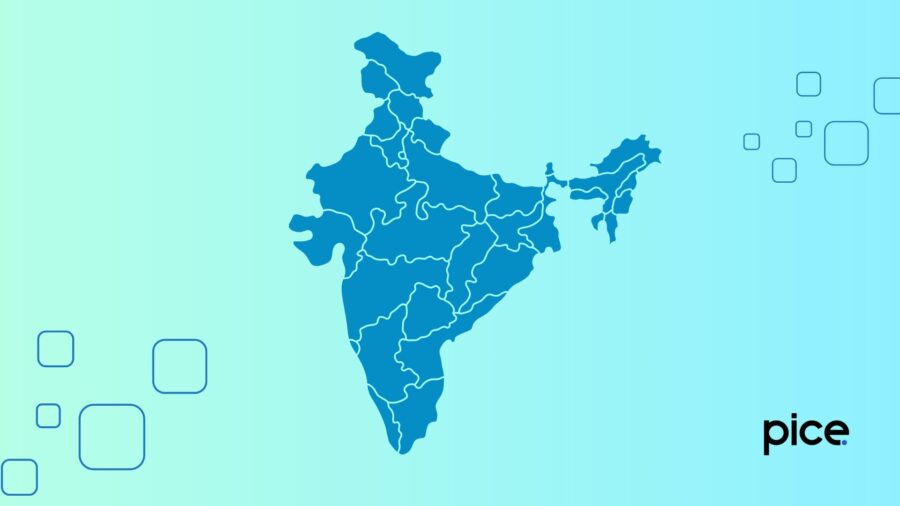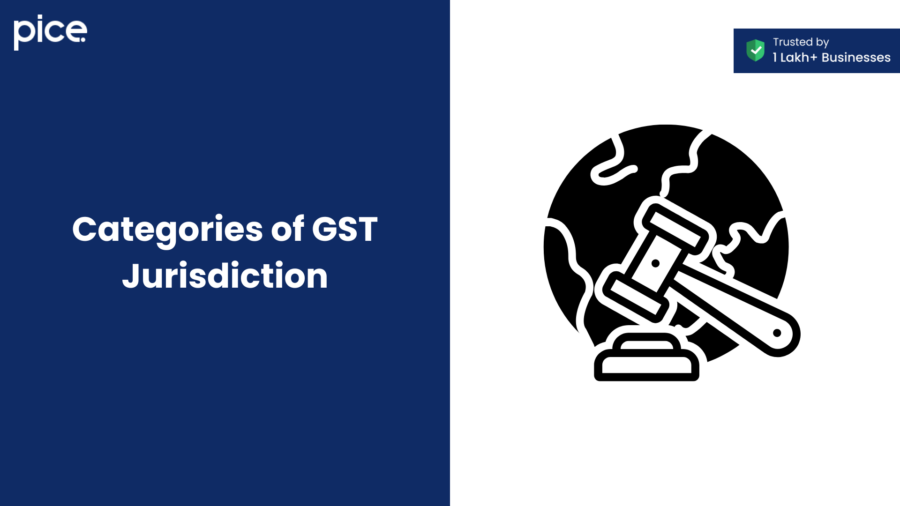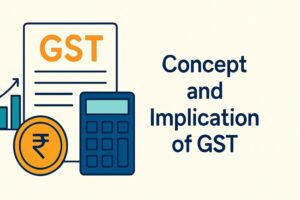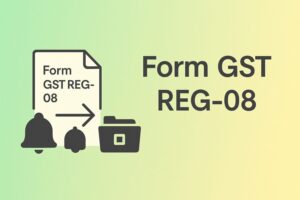GST State Code and Jurisdiction Overview
- 25 Sep 24
- 11 mins

GST State Code and Jurisdiction Overview
- Understanding the GST State Code
- Comprehensive GST State Code List for India
- When and Where the GST State Code is Required?
- Defining GST Jurisdiction
- Categories of GST Jurisdiction
- How to Find the GST Jurisdiction of Your Business?
- Importance of Knowing Your GST Jurisdiction
- Steps to Correct Incorrectly Reported GST Jurisdiction
- The Bottom Line
Key Takeaways
- The GST State Code is a two-digit alphanumeric code critical for identifying business locations and simplifying tax compliance.
- It plays a key role in GSTIN, invoices, and e-invoicing, ensuring correct tax application and supply location identification.
- Correct state codes are essential for accurate GSTR-1 and GSTR-3B filings to avoid misallocation of tax credits and penalties.
- Jurisdictions are divided by turnover, with smaller businesses under state authority and larger ones split between state and central oversight.
- Correct jurisdiction information is necessary for smooth GST registration, returns, and avoiding legal complications.
The introduction of GST can be seen as a significant change in India’s taxation structure as the GST replaced several indirect taxes. It not only made the taxation process more efficient but also made it easier to comply with laws and minimised evasion of taxes. The GST model is also distinguished by its multi-layered, integrated and destination-based structure.
One of the components of this system is the GST State Code list, which contains certain codes for each state and union territory of India. These codes are also used in the unique GST Identification Number (GSTIN) and are therefore critical to the business and taxpayers. Scroll through this blog to learn more about the GST State Code list, its significance and more.
Understanding the GST State Code
The GST State Code is defined as a 2-digit alphanumeric code that has been assigned to each state and union territory by the Government of India. These codes are crucial for knowing the type of goods or services that are traded and the business location of the trading partners. Furthermore, these codes are embedded in the Goods and Services Tax Identification Number (GSTIN), a 15-digit alphanumeric unique identification code that is assigned to every GST-registered taxpayer.
The first two digits of the GSTIN specify the state of registration for the business or the person. For instance, the first two digits of the GSTIN such as ‘29’ indicate that the particular taxpayer is registered in Karnataka. This system helps businesses quickly identify the state where a business is registered, making it easier to file GST correctly.
Comprehensive GST State Code List for India
The following table gives a comprehensive GST State Codes list for India:
| State | GST Code |
| Jammu and Kashmir | 01 |
| Himachal Pradesh | 02 |
| Punjab | 03 |
| Chandigarh | 04 |
| Uttarakhand | 05 |
| Haryana | 06 |
| Delhi | 07 |
| Rajasthan | 08 |
| Uttar Pradesh | 09 |
| Bihar | 10 |
| Sikkim | 11 |
| Arunachal Pradesh | 12 |
| Nagaland | 13 |
| Manipur | 14 |
| Mizoram | 15 |
| Tripura | 16 |
| Meghalaya | 17 |
| Assam | 18 |
| West Bengal | 19 |
| Jharkhand | 20 |
| Odisha | 21 |
| Chattisgarh | 22 |
| Madhya Pradesh | 23 |
| Gujarat | 24 |
| Dadra and Nagar Haveli and Daman and Diu | 26 |
| Maharashtra | 27 |
| Karnataka | 29 |
| Goa | 30 |
| Lakshadweep | 31 |
| Kerala | 32 |
| Tamil Nadu | 33 |
| Puducherry | 34 |
| Andaman & Nicobar Islands | 35 |
| Telangana | 36 |
| Andhra Pradesh | 37 |
| Ladakh (Newly Added) | 38 |
| Other Territory | 97 |
| Centre Jurisdiction | 99 |
When and Where the GST State Code is Required?
The GST State Code is important in several parts of the GST system. Here you will understand where it is needed:
- GST Registration
In the process of GST registration, the state code is useful in determining the geographical location and tax authority of the particular business. The jurisdiction information of both the state and the centre is required to register. The GST state code helps in providing a unique identification number to the taxpayer and also guides the taxpayer to the concerned State or Union Territory tax authority for easy registration and compliance.
- GST Invoice and e-Invoicing
The GST state code is crucial for accurate invoicing and e-invoicing under the GST system. GSTINs of sellers, buyers and consignees include the relevant state codes that help in determining the supply location. This location decides the type of GST one needs to apply, like whether it is IGST (Integrated GST) for interstate sales or CGST (Central GST) and SGST (State GST) for intrastate sales.
If a seller uses the wrong GST state code for the buyer’s GSTIN on the invoice, it could result in the incorrect GST being applied like IGST instead of CGST and SGST, or vice versa. This also means the place of supply would be recorded incorrectly. For sellers who follow e-invoicing requirements, using an incorrect state code can cause the Invoice Reference Number (IRN) to be cancelled, requiring them to issue new invoice details.
💡If you want to pay your GST with Credit Card, then download Pice Business Payment App. Pice is the one stop app for all paying all your business expenses.
- GSTR-1 and GSTR-3B Return Filing
While filing the GSTR-1 and GSTR-3B returns, the state code is used to categorise the business transactions based on the state or the union territory. This classification is useful in establishing the correct state-wise tax amount that is payable and in distributing revenues to the correct states.
Currently, the GST portal does not have any check to validate the GSTIN on the tax invoice in GSTR-1 other than the e-invoice portal in some cases. In the worst-case scenario where a seller incorrectly enters the wrong GST state code when entering the GSTIN on the invoice, the credit will be recorded under the wrong GSTIN or the wrong person rather than the actual buyer.
Defining GST Jurisdiction
GST jurisdiction is crucial in defining which tax body whether state or central is in charge of a business entity’s tax returns and remittances. It is based on turnover thresholds, where businesses that have a turnover of less than ₹1.5 crore primarily come under state authority while those above this amount are categorised under both state and centre authorities. Such a division makes the process of tax administration easy as well as guarantees that the businesses involved follow specific regulations of the jurisdiction assigned to them.
Organising jurisdictions through regional boundaries like PIN codes, simplifies processes such as filing returns, audits and dispute resolution. Accurately determining and following the correct GST jurisdiction is crucial for seamless operations within the GST framework.
Categories of GST Jurisdiction

GST jurisdiction is divided into two main types which are as follows:
- State Jurisdiction
This involves handling tax affairs within a specific state or union territory, including the collection and assessment of SGST and UTGST. States are divided into multiple jurisdictions, each managed by a Jurisdictional Officer.
- Central Jurisdiction
This deals with CGST and IGST. It handles transactions that take place across different states or union territories, ensuring proper tax collection and distribution among the states.
According to CGST Circular no. 21/2017 of 20th September 2017, the jurisdiction division is as follows:
- For Taxpayers with Turnover Below ₹1.5 Crore
Most of these taxpayers, about 90%, fall under State jurisdiction, while the remaining 10% are managed by the Central administration.
- For Taxpayers with Turnover Above ₹1.5 Crore
Here, the jurisdiction is evenly split. 50% of these taxpayers are under State administration, and the other 50% are overseen by the Central administration.
This categorisation is handled through computer-based processes at the state level, taking into account factors like the taxpayer's location and registration type.
How to Find the GST Jurisdiction of Your Business?

To determine the GST jurisdiction for your business, you can use any of the following methods:
Method 1: Using the CBIC Portal (For State Jurisdiction)
Follow the step-by-step procedure to find the state jurisdiction with the CBIC portal:
Step 1: Go to the Central Board of Indirect Taxes and Customs (CBIC) portal: CBIC GST Portal.
Step 2: Find the ‘Services’ section on the portal.
Step 3: Tap on ‘Know Your Jurisdiction'.
Step 4: You will be redirected to a list of States and Union Territories.
Step 5: Choose the State/UT you are interested in.
Step 6: Select the zone, commissionerate, division and range.
Step 7: Review the localities under that range.
Method 2: Using the GST Portal with GSTIN (For Both State and Central Jurisdiction)
Here are the steps you need to follow to find your GST jurisdiction using the GST portal:
Step 1: Go to the official GST Portal.
Step 2: Tap on ‘Search Taxpayer’ on the homepage.
Step 3: Choose ‘Search by GSTIN/UIN’ from the dropdown menu.
Step 4: Provide the 15-digit GSTIN for your business.
Step 5: Click the ‘Submit’ or ‘Search’ option.
The page will show detailed jurisdiction information for the given GSTIN.
Method 3: Using State Websites
Follow the steps to find GST jurisdiction using the website of the state in which you are residing:
Step 1: Go to the official GST portal of the specific state.
Step 2: Find the section related to taxpayer services or GST.
Step 3: Find the ‘Know Your Jurisdiction’ or ‘Jurisdiction’ option.
Step 4: Provide the required business entity details, such as GSTIN.
Step 5: Tap on the ‘Submit’ or ‘Search’ option.
The website will provide jurisdictional details specific to that state.
Importance of Knowing Your GST Jurisdiction
Understanding your GST jurisdiction and state codes is crucial for several reasons:
- Jurisdictional Compliance
Each business has to register under the GST law where their principal place of business lies. This is important because knowing your jurisdiction allows you to be certain that you are operating under the right laws of that area.
- Interstate Transactions
Interstate trade plays a crucial role in the economy of a large country like India. It is easy for businesses to determine the source and destination states of their transactions when they know GST state codes.
- GST Returns and Filing
It is vital not to submit a wrong GST return as it will lead to non-compliance. This is important as it allows you to know how to report transactions in the returns according to the GST state code. Mistakes in reporting may cause a variance, audit or penalty.
- Input Tax Credit (ITC)
Under GST, the Input Tax Credit (ITC) is available to businesses on the GST charged on the acquisition of goods and services. To benefit from this, all GST details on invoices including the state codes need to be correct. Some of the problems in state code cause rejection of ITC claims.
- Avoiding Legal Issues
Lack of knowledge of GST state codes and jurisdictions results in non-compliance by default and then legal implications. Being aware of these codes helps businesses avoid such problems and ensures they stay compliant with the law.
- Trade Across Borders
As we know GST is implemented based on statewide codes, thus for companies who are involved in international business it is very important to learn about the GST State codes. It assists in distinguishing between domestic and cross-border transactions and helps in properly applying custom duties as well as GST.
- GST Software and Technology
Most companies employ software to help them meet GST compliance requirements. These tools rely heavily on the GST state codes and jurisdiction for any given area. It makes sure that software systems can handle transactions without any flaws or errors.
Steps to Correct Incorrectly Reported GST Jurisdiction
If you chose the wrong jurisdiction during the GST registration, you can correct it by submitting a request for a change in jurisdiction details. This request should be directed to the relevant administrative or IT cell of the concerned state. Once the submission is made, the necessary adjustments will be processed to update the jurisdiction information.
The Bottom Line
Understanding the GST State Code list is crucial for you to be able to make the right tax filing. Knowing your GST state code and jurisdiction will help you with the GST registration of your business, dealing with interstate sales, performing the tax return processing correctly and also avoiding legal complications. It is important to have accurate knowledge of these codes to enhance operations and input tax credit recovery. Moreover, you must always ensure that your jurisdiction details are correct for legal compliance and to avoid any additional issues.
 By
By 

















